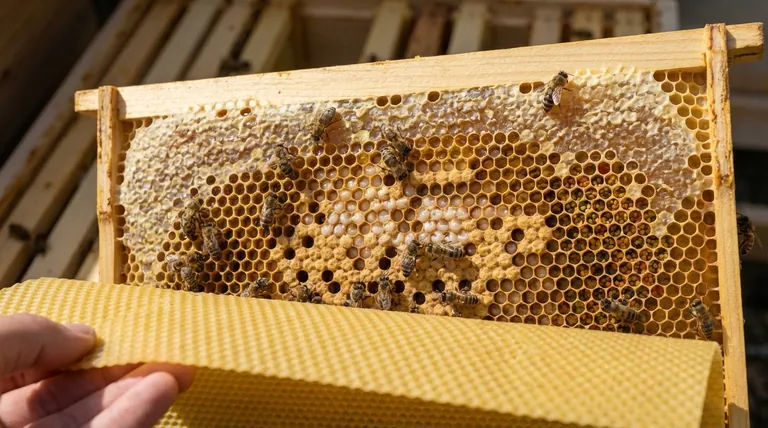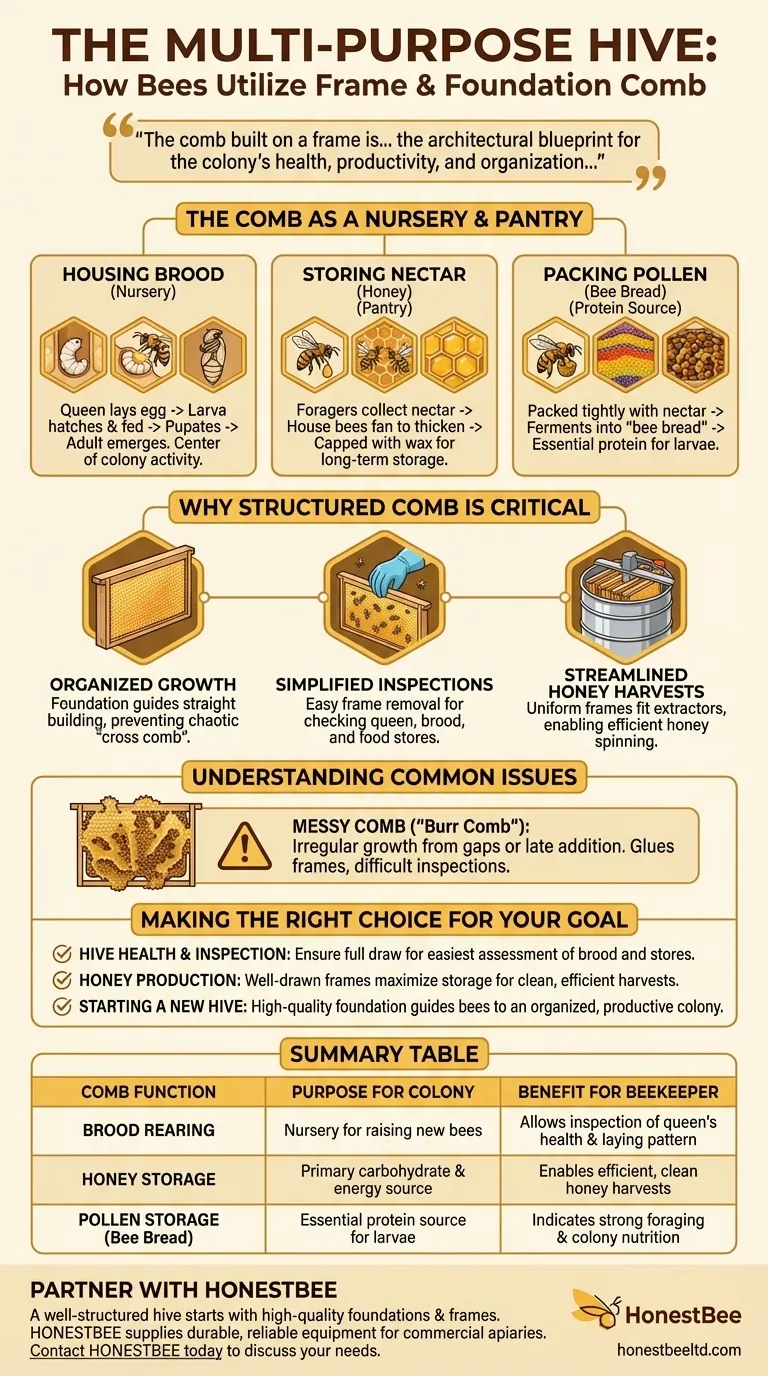Once bees draw out comb on a frame's foundation, they use it as the central structure for their entire colony. Each hexagonal cell serves one of three essential purposes: raising new bees (brood), storing nectar that will become honey, or packing pollen to create a protein source known as bee bread. This comb is the hive's nursery, pantry, and lifeblood, all built upon the framework you provide.
The comb built on a frame is far more than simple storage. It is the architectural blueprint for the colony's health, productivity, and organization, directly influencing both the bees' efficiency and the beekeeper's ability to manage the hive.

The Comb as a Multi-Purpose Nursery and Pantry
Bees are masters of efficiency, and the comb they build is a perfect example. Every cell is meticulously constructed and serves a specific, vital function for the colony's survival and growth.
Housing Brood
The very center of the hive's activity revolves around raising the next generation. The queen bee lays a single egg in each cell, which then hatches into a larva. Worker bees feed the larva within its cell until it pupates and eventually emerges as an adult bee, ready to contribute to the colony.
Storing Nectar
Foraging bees collect nectar from flowers and deposit it into comb cells. Inside the hive, house bees work to reduce the nectar's water content by fanning it with their wings. Once it thickens into honey, they cap the cell with a fresh layer of wax, preserving it as the colony's primary carbohydrate and energy source.
Packing Pollen (Bee Bread)
Pollen is the bees' essential source of protein and fats. Foragers carry it back to the hive on their legs and pack it tightly into cells. They often mix it with a small amount of nectar, allowing it to ferment slightly into what beekeepers call "bee bread," a preserved food vital for feeding developing larvae.
Why a Structured Comb is Critical
While bees can build comb anywhere, the frames and foundation provided by a beekeeper are not just a convenience—they are fundamental to modern beekeeping. This structure brings order to the hive's natural tendencies.
Facilitating Organized Growth
A foundation, whether wax or plastic, provides a guide. It encourages the bees to build straight, even combs that are contained within the wooden frame. This prevents them from building chaotic "cross comb" that connects multiple frames, making the hive impossible to manage without destroying their work.
Simplifying Hive Inspections
The ability to remove individual frames is the cornerstone of responsible beekeeping. It allows you to check the queen's laying pattern, look for signs of disease or pests, and assess the colony's food stores without tearing the hive apart. An organized comb makes these inspections smooth and minimally disruptive.
Streamlining Honey Harvests
For beekeepers focused on honey production, uniform frames are essential. Fully drawn, straight combs can be easily uncapped and placed in an extractor, which spins the honey out via centrifugal force. This process is impossible with messy, irregular comb.
Understanding Common Comb Issues
Even with a foundation, bees can sometimes build in ways that are counterproductive for the beekeeper. Understanding why this happens is key to preventing it.
The Problem of Messy Comb
Irregular comb often occurs when bees build comb raised off the foundation or in gaps between frames. This "burr comb" can act like glue, making it difficult or impossible to pull a frame for inspection without tearing the comb and angering the bees.
Causes of Irregularity
Messy comb is often a symptom of another issue. It can happen if a frame was added too late in the season and never fully drawn out, if it was damaged during storage, or if the spacing between frames in the hive box is incorrect.
Making the Right Choice for Your Goal
Understanding how bees use the comb directly informs how you should manage your hive. The structure you provide dictates the results you will get.
- If your primary focus is hive health and inspection: Ensure bees fully draw out comb on the foundation, as this allows for the easiest and clearest assessment of brood patterns and food stores.
- If your primary focus is honey production: A hive full of well-drawn frames provides the maximum possible storage area and is essential for an efficient and clean harvest.
- If you are starting a new hive: Providing a high-quality foundation from the beginning is one of the most important steps to guide your bees toward building an organized and productive colony.
By understanding the comb's central role, you transition from simply keeping bees to actively partnering with them to build a thriving colony.
Summary Table:
| Comb Function | Purpose for the Colony | Benefit for the Beekeeper |
|---|---|---|
| Brood Rearing | Nursery for raising new bees | Allows inspection of queen's health and laying pattern |
| Honey Storage | Primary carbohydrate and energy source | Enables efficient, clean honey harvests |
| Pollen Storage (Bee Bread) | Essential protein source for larvae | Indicates strong foraging and colony nutrition |
Partner with HONESTBEE for a More Productive Apiary
A well-structured hive starts with high-quality foundations and frames. At HONESTBEE, we supply commercial apiaries and beekeeping equipment distributors with the durable, reliable supplies needed to guide bees toward building organized, productive colonies. From strong foundations that prevent messy comb to equipment that streamlines inspections and harvests, our wholesale-focused operations are designed to support your success.
Contact HONESTBEE today to discuss your apiary's needs and discover how our equipment can become the foundation for your hive's health and honey production.
Visual Guide

Related Products
- Manual Beeswax Comb Foundation Machine Wax Foundation Mill Embossing Machine
- Beeswax Foundation Sheets Beehive Foundation for Wholesale
- Colorful Silicone Beeswax Foundation Mold Mould for Beekeeping
- Food Grade Plastic bee Foundation for Bee Frames
- Professional Frame Preparation: The HONESTBEE Electric Wire Embedder
People Also Ask
- What texture is embossed on the beeswax foundation machine? The Precise Worker Bee Cell Pattern for Hive Efficiency
- Why is it beneficial to make your own beeswax foundation? Gain Control Over Cost, Purity & Hive Health
- How should stuck wax on mill rollers be removed? A Gentle, Non-Damaging Cleaning Method
- How do honeybees use wax in their hives? The Key to Colony Survival and Structure
- What is the importance of soaping the rollers during milling? Prevent Wax Adhesion & Equipment Downtime
















